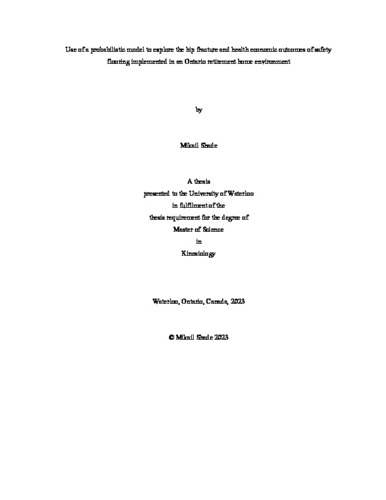| dc.description.abstract | Hip fractures suffered by older adults are a serious public health concern. The direct yearly expenditure for hip fractures exceeds one billion dollars in Canada and with the older adult population expected to increase within the upcoming years, this issue will become more significant. Hip fractures therefore require consistent, structured investigations into their mechanism, and any insight which could mitigate the challenges associated with their occurrence, should be actively pursued. Hip fracture investigations frequently employ the factor of risk principle which posits that a hip fracture occurs when the loads applied to the hip exceed the strength of the bone. Appropriately designed safety flooring reduces fall-related impact forces and should theoretically reduce hip fracture risk, however, when implemented into an older adult setting the expected reduction in hip fracture risk is not observed. Yet still economic evaluations of safety flooring suggest that it is a better alternative than standard flooring, supporting its inclusion into older adult settings.
Mathematical modelling provides a cost-effective, non-invasive, investigative tool which can be used in tandem with experimental and observational approaches to consider hip fracture risk. A previous model unified experimental and observational data to simulate a population of Canadian older adults, subsequently quantifying their hip fracture risk using the factor or risk principle. However, the simulated population may not be representative of distinct subsets of the Canadian older adult population. Additionally, the model can only assess hip fracture risk in two unique conditions: when the entire population falls on safety flooring, or the entire population falls on standard flooring. These limitations reduce confidence in the model’s ability to quantify hip fracture risk for arbitrary populations and reduce the model’s ability to replicate situations which are objectively more feasible to recreate in the real-world.
The objectives of this thesis were to expand the capabilities of the pre-existing probabilistic model, increase its real-world utility by integrating components to simulate specific subpopulations of older adults, incorporate the probabilities of falls in different locations, and consider the economics of implementing safety flooring in specific locations within residential care facilities. The modified probabilistic model supports the notion of population-specific/population-dependent investigations. It also reaffirms the accuracy of understood model assumptions by exhibiting similar behaviours across different populations. Additionally, the model successfully integrated fall location probabilities from observational data to highlight an effect of sex and location on hip fracture risk. Finally, the model suggests that both savings and decisions to implement safety flooring may depend not only on the location of falls but sex characteristics as well.
Ultimately, this thesis demonstrates the feasibility of coupling mechanics, epidemiology, and health economics perspectives within a simulation tool to explore the effects of a safety flooring intervention on hip fracture risk in a retirement home setting on older adult hip fracture risk. The outcomes of this thesis may assist decision-makers within multiple industries (residential care facilities, flooring manufacturers, government policy makers) in developing funding policies, priorities, and design decisions. | en |

